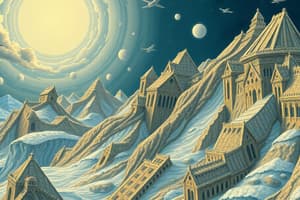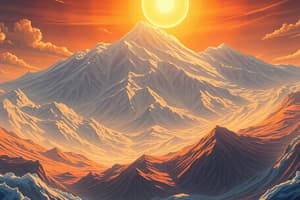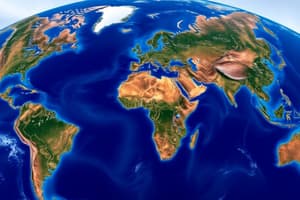Podcast
Questions and Answers
What was the northern part of Pangaea called?
What was the northern part of Pangaea called?
- Tethys
- Panthalassa
- Gondwanaland
- Laurasia (correct)
Which ancient ocean existed between Laurasia and Gondwanaland?
Which ancient ocean existed between Laurasia and Gondwanaland?
- Atlantic Ocean
- Pacific Ocean
- Indian Ocean
- Tethys (correct)
Which of the following was a dominant plant of Gondwana?
Which of the following was a dominant plant of Gondwana?
- Cycads
- Glossopteris (correct)
- Ferns
- Ginkgo
What characteristic is associated with the Cynognathus?
What characteristic is associated with the Cynognathus?
Which animal is described as a freshwater carnivore with a long head and flattened tail?
Which animal is described as a freshwater carnivore with a long head and flattened tail?
What evidence supported the theory that continents were once joined?
What evidence supported the theory that continents were once joined?
What was the estimated timeframe for Pangaea's breakup?
What was the estimated timeframe for Pangaea's breakup?
What does the name 'Lystrosaurus' mean?
What does the name 'Lystrosaurus' mean?
Who was the first to note the fit between South America and Africa?
Who was the first to note the fit between South America and Africa?
What did Eduard Suess propose based on the distribution of fossils?
What did Eduard Suess propose based on the distribution of fossils?
What name did Eduard Suess give to the southern supercontinent?
What name did Eduard Suess give to the southern supercontinent?
Which geologist theorized that all continents were once joined together?
Which geologist theorized that all continents were once joined together?
What did Alexander du Toit use to support his theory of a supercontinent?
What did Alexander du Toit use to support his theory of a supercontinent?
What was Wegener's term for the supercontinent he theorized?
What was Wegener's term for the supercontinent he theorized?
Which of the following proposed that continents were dragged towards the equator?
Which of the following proposed that continents were dragged towards the equator?
What does 'protocontinent' refer to in the context of Wegener's theory?
What does 'protocontinent' refer to in the context of Wegener's theory?
Study Notes
Continental Drift and Supercontinents
- Alfred Wegener, a German geophysicist (1880-1930), identified the fitting shapes of South America and Africa in 1912, suggesting continents' prior connectivity.
- Abraham Ortelius first noted the South America-Africa fit in the 16th century, highlighting long-ago observations of continental formations.
- Austrian geologist Eduard Suess proposed land bridges connecting southern continents based on fossil evidence of the Glossopteris fern found across India, South America, southern Africa, Australia, and Antarctica.
- Suess named the southern supercontinent Gondwanaland after the Gondwana region of India where fossils were identified.
- Gondwanaland formed after the breakup of the supercontinent Pangaea, with its northern counterpart identified as Laurasia.
Important Theories and Contributions
- Roberto Mantovani mapped former continental positions and theorized in the late 19th and early 20th centuries that continents drifted apart from a unified supercontinent.
- Frank Bursley Taylor (1908) proposed that continents moved toward the equator due to the moon's gravitational pull, contributing to formations like the Himalayas and Alps.
- South African geologist Alexander du Toit supported the supercontinent theory with fossil findings of the Mesosaurus in South America and South Africa, illustrating historical connections.
- Wegener referred to his supercontinent as Pangaea, meaning “all lands,” and proposed that one large ocean, Panthalassa, surrounded it.
Breakup and Structural Details
- Pangaea is believed to have existed until about 300 million years ago before breaking into Laurasia and Gondwanaland.
- Laurasia included present-day North America, Europe, and Northern Asia, breaking apart around 66 to 30 million years ago.
- Gondwanaland fragmented approximately 180 million years ago into Africa, South America, Australia, Antarctica, the Indian subcontinent, and the Arabian Peninsula.
- The Tethys Ocean was situated between Laurasia and Gondwanaland, representing ancient marine environments.
Significant Fossils and Their Implications
- Glossopteris, an extinct fern with tongue-shaped leaves, thrived in Gondwanaland and provided crucial fossil evidence for the idea of connected continents.
- Mesosaurus, a freshwater reptile with aquatic adaptations, indicated land connection through identical fossil finds in South America and Africa.
- Cynognathus, meaning "dog jaw," was a mammal-like reptile found in Africa and Argentina, demonstrating geographical links.
- Lystrosaurus ("shovel reptile") fossils point to similar herbivorous life across continents, contributing to evidence for past continental unity.
Studying That Suits You
Use AI to generate personalized quizzes and flashcards to suit your learning preferences.
Description
Explore the history and development of the Continental Drift theory, first noted by Alfred Wegener in 1912. This quiz covers significant figures like Wegener, Ortelius, and Suess, who contributed to our understanding of the connection between continents. Test your knowledge on the geological concepts and evidence supporting this transformative theory.





